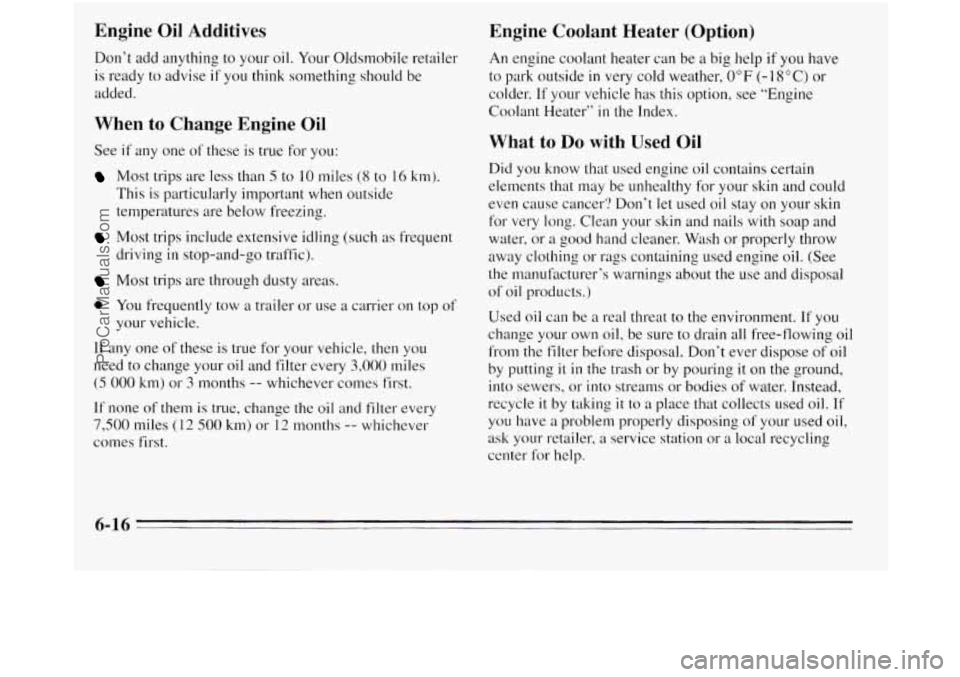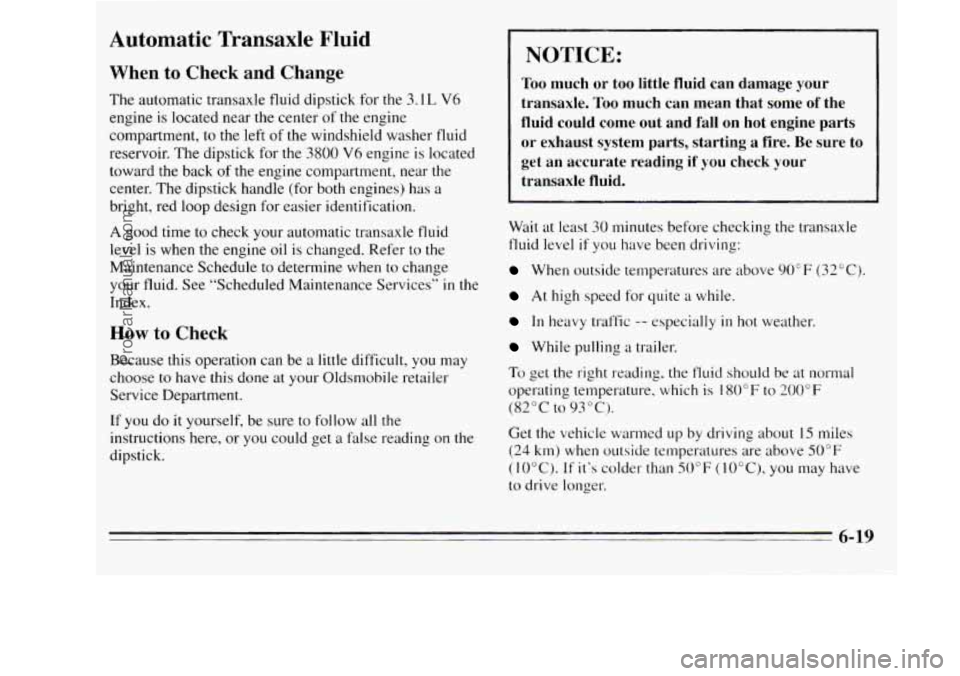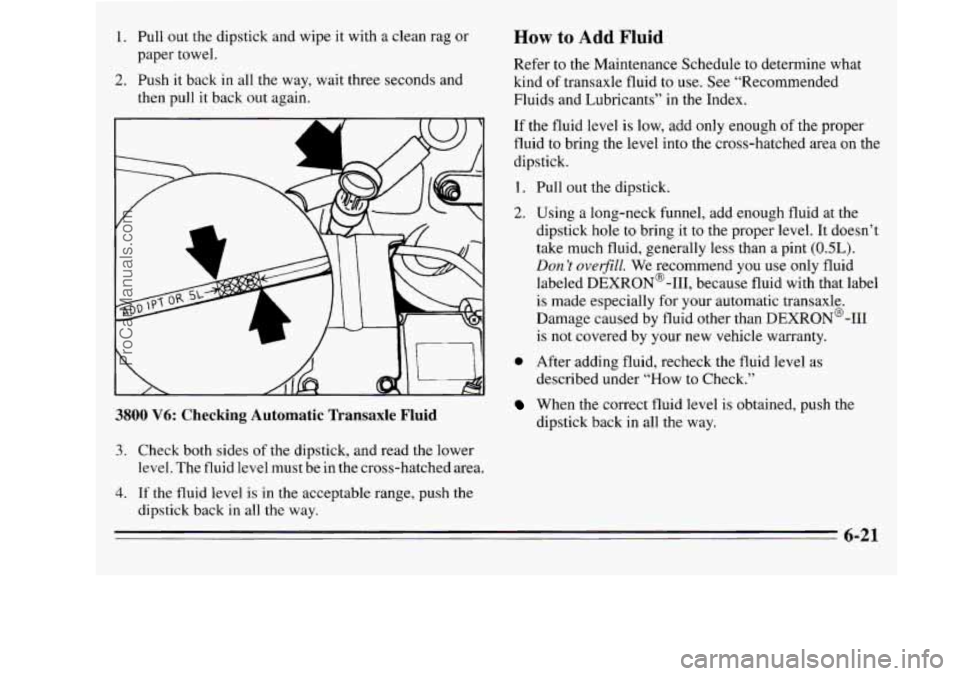Page 276 of 390

Engine Oil Additives
Don’t add anything to your oil. Your Oldsmobile retailer
is ready
to advise if you think something should be
added.
When to Change Engine Oil
See if any one of these is true for you:
Most trips are less than 5 to 10 miles (8 to 16 krn).
This
is particularly important when outside
temperatures are below freezing.
Most trips include extensive idling (such as frequent
driving
in stop-and-go traffic).
Most trips are through dusty areas.
0 You frequently tow a trailer or use a carrier 011 top of
your vehicle.
If any one
of these is true for your vehicle, then you
need to change your oil and filter every
3,000 miles
(5 000 km) or 3 months -- whichever comes first.
If none
of them is true, change the oil and filter every
7,500 miles (12 500 km) or I2 months -- whichever
comes first.
Engine Coolant Heater (Option)
An engine coolant heater can be a big help if you have
to park outside
in very cold weather, 0°F (- 18OC) or
colder.
If your vehicle has this option, see “Engine
Coolant Heater”
in the Index.
What to Do with Used Oil
Did you know that used engine oil contains certain
elements that may
be unhealthy for your skin and could
even cause cancer? Don’t let used oil stay on your skin
for very long. Clean your skin and nails with soap and
water, or
a good hand cleaner. Wash or properly throw
away clothing or rags containing used engine oil. (See
the manufacturer’s warnings about the use and disposal
of oil products.)
Used oil can be
a real threat to the environment. If you
change your own oil, be sure
to drain all free-flowing oil
from the filter before disposal. Don’t ever dispose of oil
by putting it
in the trash or by pouring it on the ground,
into sewers, or into streams or bodies of water. Instead,
recycle
it by taking it to a place that collects used oil. If
you have a problem properly disposing of your used oil,
ask your retailer, a service station or a local recycling
center for help.
6-16
ProCarManuals.com
Page 277 of 390
Air Cleaner
The air cleaner for the 3.1L V6 engine is circular in
shape and is located toward the back of the engine
compartment, near the center.
The air cleaner for the 3800 V6 engine is located at the
front
of the engine compartment (on the driver’s side of
the vehicle), to the left of the windshield washer fluid
reservoir.
Refer to the Maintenance Schedule
to determine when to
replace the air filter and the crankcase ventilation filter.
See “Scheduled Maintenance Services’’
in the Index.
I NOTICE:
If the air cleaner is off, a backfire can cause a
damaging engine fire. And, dirt can easily get into your engine, which
will damage it. Always
have the air cleaner in place when you’re driving.
ProCarManuals.com
Page 278 of 390
3.1L V6: Checking the Air Cleaner Filter
To Check or Replace (3.1L V6)
1. Remove the large wing nut and lift the cover.
2. Remove the air cleaner filter.
3. Be sure to install the air cleaner filter, replace the
cover and tighten the wing
nut securely.
3800 V6: Replacing the Air Cleaner Filter
To Check or Replace (3800 V6)
1. Loosen the four wing nuts.
2. Pull the top of the air cleaner toward the front of the
vehicle and remove the air cleaner filter.
3. Be sure to install the air cleaner filter, replace the
cover and tighten the wing nuts securely.
6-18
ProCarManuals.com
Page 279 of 390

Automatic Transaxle Fluid
When to Check and Change
The automatic transaxle fluid dipstick for the 3.1 L V6
engine is located near the center of the engine
compartment, to the left
of the windshield washer fluid
reservoir. The dipstick for
the 3800 V6 engine is located
toward the back
of the engine Compartment, near the
center. The dipstick handle (for both engines) has
a
bright, red loop design for easier identification.
A good time to check your automatic transaxle fluid
level is when the engine oil is changed. Refer to the
Maintenance Schedule to determine when to change
your fluid. See “Scheduled Maintenance Services”
in the
Index.
How to Check
Because this operation can be a little difficult, you may
choose to have this done at your Oldsmobile retailer
Service Department.
If
you do it yourself, be sure to follow all the
instructions here, or
you could get a false reading on the
dipstick.
NOTICE:
Too much or too little fluid can damage your
transaxle.
Too much can mean that some of the
fluid could come out and fall on hot engine parts
or exhaust system parts, starting a fire. Be sure to
get
an accurate reading if you check your
transaxle fluid.
Wait at least 30 minutes before checking the transaxle
fluid level
if you have been driving:
When outside temperatures are above 90°F (32°C).
At high speed for quite a while.
In heavy traffic -- especially in hot weather.
While pulling a trailer.
To get the right reading, the fluid should be at normal
operating temperature, which is 180°F
to 200°F
(82°C to 93°C).
Get the vehicle warmed up by driving about 15 miles
(24 km) when outside temperatures are above 50°F
(10°C).
If it’s colder than 50°F (lO°C), you may have
to drive longer.
ProCarManuals.com
Page 281 of 390

1. Pull out the dipstick and wipe it with a clean rag or
2. Push it back in all the way, wait three seconds and
paper towel.
then pull it back out again.
How to Add Fluid
Refer to the Maintenance Schedule to determine what
kind
of transaxle fluid to use. See “Recommended
Fluids and Lubricants”
in the Index.
r 1 L 7
3800 V6: Checking Automatic Transaxle Fluid
3. Check both sides of the dipstick, and read the lower
level.
The fluid level must be in the cross-hatched area.
4. If the fluid level is in the acceptable range, push the
dipstick back
in all the way.
If the fluid level is low, add only enough of the proper
fluid to bring the level into the cross-hatched area
on the
dipstick.
1. Pull out the dipstick.
2. Using a long-neck funnel, add enough fluid at the
dipstick hole to bring it to the proper level. It doesn’t
take much fluid, generally less than
a pint (OSL).
Don’t overfill. We recommend you use only fluid
labeled DEXRON@-111, because fluid with that label
is made especially for your automatic transaxle.
Damage caused by fluid other than DEXRON@-I11
is not covered by your new vehicle warranty.
0 After adding fluid, recheck the fluid level as
described under “How to Check.”
When the correct fluid level is obtained, push the
dipstick back in all the way.
6-21
ProCarManuals.com
Page 283 of 390
Adding Coolant
The engine coolant reservoir is located on the
passenger’s side
of the vehicle, towards the middle of
the engine compartment.
3.1L V6: Checking Coolant
3800 V6: Checking Coolant
To Check Coolant
When your engine is cold, the coolant level should be at
COLD, or a little higher. When your engine is warm, the
level should be up to
FULL HOT, or a little higher.
6-23
ProCarManuals.com
Page 285 of 390
Power Steering Fluid
3.1L V6: Checking the Power Steering Fluid
The power steering fluid reservoir for the 3.1L V6
engine is located toward the back of the engine
compartment, to the
left of the circular air cleaner.
~~~ ~~~
3800 V6: Checking the Power Steering Fluid
The power steering fluid reservoir for the 3800 V6
engine is located to the right of the engine coolant
reservoir, at the very back
of the engine compartment.
~ 6-25
ProCarManuals.com
Page 286 of 390

How To Check Power Steering Fluid
When the engine compartment is cool, unscrew the cap
and wipe the dipstick with
a clean rag. Replace the cap
and completely tighten
it. Then remove the cap again
and look at the fluid level
on the dipstick.
The level should be at the
FULL COLD mark. Add
enough fluid to bring the level up to the mark.
A fluid loss in this system could indicate a problem.
Have the system inspected and repaired.
What to Add
Refer to the Maintenance Schedule to determine what
kind
of fluid to use. See ‘‘Recommended Fluids and
Lubricants”
in the Index.
Windshield Washer Fluid
To Add
NOTICE:
When adding power steering fluid or making a
complete fluid change, always use the proper
fluid. Failure to use the proper fluid can cause
leaks and damage hoses and seals.
The windshield washer fluid reservoir is located on the
driver’s side of the vehicle, toward the front
of the
engine compartment.
Open the cap labeled
WASHER FLUID ONLY. Add
washer fluid
until the tank is full.
6-26
ProCarManuals.com